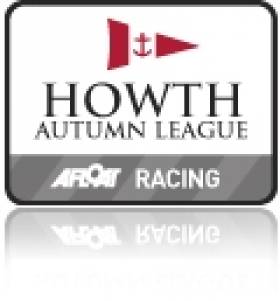Displaying items by tag: Puppeters
Strong Conditions for Second Race at Howth's WD-40 Autumn League
In stark contrast to the previous weekend, when lack of wind prevented racing, the second race of the WD-40 Autumn League at Howth Yacht Club was sailed in fresh and gusty south-westerlies which had a bearing on a dozen non-finishers among the 150 boats on the entry list.
Half of the classes witnessed second successive wins for the leading boats, with Class 1, 2 and 3 being headed again by ‘Storm’ (Pat Kelly), ‘Dux’ (Anthony Gore-Grimes) and ‘Quickflash’ (Alfred Mayrs) respectively. In the one-design classes, there were wins on the double for Jay Bourke in the Etchells, Callen & Stanley in the Puppeteers, Craig & Ruane in the Squibs and Peter Courtney in the 17s.
Indeed, the latter two had impressive victories, with Craig & Ruane winning by over 5 minutes and Courtney having almost the same margin over second-placed ‘Deilginis’, results which also gained them handicap wins too.
‘Mojo’ (Callen & Stanley) had a minute and a half to spare over ‘Gold Dust’ (Walls & Browne) and that was enough to win on handicap as well and Mossy Shanahan’s ‘Crazy Horse’ had a similar gap at the top of the J24 fleet ahead of ‘Scandal’, the Malahide boat loaned to the HYC Development Squad (Red Team) who were a mere 12 seconds behind the other HYC Development Squad in the borrowed ‘Kilcullen’.
A notable absentee was J/24 National Champion Flor O’Driscoll who was in Lough Derg at the ISA All-Ireland Sailing Championship where he finished 5th overall, just one place behind another HYC representative, SB3 champion Ben Duncan.
Jay Bourke’s ‘Dirty Protest’ had almost two minutes on ‘Jabberwocky’ (Simon Knowles) in the Etchells although Simon’s father Andy (‘Sandpiper’) fared better in Class 5, winning by over 3 minutes corrected (on ECHO) from ‘Demelza’ (Ennis/Laudan)(which now holds the overall lead), while Harry Byrne’s ‘Alphida’ recorded another IRC win.
Class 4 saw ‘Sojourn’ (Lacy/Blandford) win fairly handily from ‘Changeling’ (Kieran Jameson) on ECHO while ‘Changeling’ took the IRC honours to head that division overall.
Class 3 has the distinction of having the most visiting boats of any class and the local boats are finding it difficult to disrupt the performances of the visitors. Alfred Mayrs ‘Quickflash’ from Antrim won again on IRC, although only narrowly from Malahide’s ‘Goyave’ (Camier/Fitzpatrick), with the positions reversed on ECHO.
It was a top three repeat performance in Class 2, where ‘Dux’ (Anthony Gore-Grimes) again headed the 14-boat fleet, with ‘Indigo’ (Ritchie/Eadie) and ‘Maximus’ (Paddy Kyne) against 2nd and 3rd respectively on IRC, with the top two swapping positions on ECHO both in the race and in the overall rankings.
Unsurprising, ‘Crazy Horse’ took line honours in Class 1 but it was Pat Kelly’s ‘Storm’ which enjoyed a comfortable IRC win over ‘Tiger’ (Harris/Hughes) although the positions were the other way around on ECHO.
The third race in the WD-40 Autumn League sponsored by Team PR Reilly, is schedule for next Sunday morning, October 16th.
HOWTH YACHT CLUB. AUTUMN LEAGUE (RACE) 09/10/2011 Class 1 IRC: 1, Storm P Kelly HYC; 2, Tiger Harris/Hughes HYC; 3, Crazy Horse Chambers/Reilly HYC; Class 1 ECHO: 1, Tiger Harris/Hughes HYC; 2, Storm P Kelly HYC; 3, Makutu Doyle/Others HYC; Class 2 IRC: 1, Dux A Gore-Grimes HYC; 2, Indigo Ritchie/Eadie HYC; 3, Maximus P Kyne HYC; Class 2 ECHO: 1, Indigo Ritchie/Eadie HYC; 2, Dux A Gore-Grimes HYC; 3, Maximus P Kyne HYC; Class 3 IRC: 1, Quickflash A Mayrs ABSC; 2, Goyave Camier/Fitzpatrick MYC; 3, Starlet E Bourke HYC; Class 3 ECHO: 1, Goyave Camier/Fitzpatrick MYC; 2, Quickflash A Mayrs ABSC; 3, Starlet E Bourke HYC; Class 4 ECHO: 1, Sojourn Lacy/Blandford HYC; 2, Changeling K Jameson HYC; 3, Trinculo M Fleming HYC; Class 4 IRC: 1, Changeling K Jameson HYC; 2, Trinculo M Fleming HYC; 3, Bite the Bullet C Bermingham HYC; Class 5 ECHO: 1, Sandpiper A Knowles HYC; 2, Demelza Ennis/Laudan HYC; 3, Alphida H Byrne HYC; Class 5 IRC: 1, Alphida H Byrne HYC; 2, Demelza Ennis/Laudan HYC; 3, Sandpiper A Knowles HYC; Puppeteer SCRATCH: 1, Mojo Callen/Stanley HYC; 2, Gold Dust Walls/Browne HYC; 3, Trick or Treat A Pearson HYC; Puppeteer HPH: 1, Mojo Callen/Stanley HYC; 2, Gold Dust Walls/Browne HYC; 3, Weh Hey T Kennedy HYC; Squib SCRATCH: 1, Kerfuffle Craig/Ruane HYC; 2, Too Dee D Sheahan HYC; 3, Puffin E Harte HYC; Squib HPH: 1, Kerfuffle Craig/Ruane HYC; 2, Too Dee D Sheahan HYC; 3, Puffin E Harte HYC; 17 Footer SCRATCH: 1, Oona P Courtney HYC; 2, Deilginis Deilginis HYC; 3, Leila R Cooper HYC; 17 Footer HPH: 1, Oona P Courtney HYC; 2, Deilginis Deilginis HYC; 3, Leila R Cooper HYC; Etchells SCRATCH: 1, Dirty Protest J Bourke HYC/GSC; 2, Jabberwocky S Knowles HYC; 3, Glance O'Reilly/Dix HYC; J 24 SCRATCH: 1, Crazy Horse M Shanahan HYC; 2, Scandal HYC Dev Sq Red HYC; 3, Kilcullen HYC Dev Sq White HYC





























































